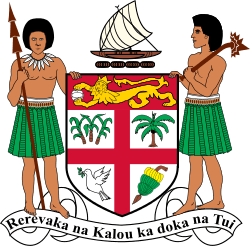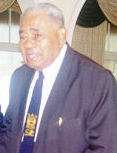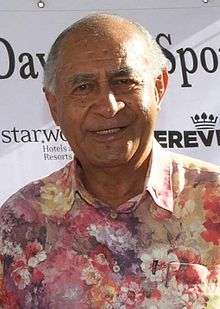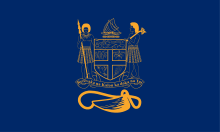President of Fiji
| President of the Republic of Fiji | |
|---|---|
|
Presidential Standard | |
| Residence | Government House, Suva |
| Appointer | Parliament of Fiji |
| Term length | 3 years |
| Inaugural holder | Penaia Ganilau |
| Formation | 5 December 1987 |
 |
| This article is part of a series on the politics and government of Fiji |
|
Legislative
|
|
Judiciary |
|
The President of the Republic of Fiji is the Head of State of Fiji. The President is appointed by the Parliament of Fiji for a three-year term under the terms of the 2013 Constitution of Fiji.[1] Although not entirely a figurehead, the President's role in government is mostly ceremonial, but there are important reserve powers that may be exercised in the event of a crisis. In addition, the President is Commander-in-Chief of the Military Forces.
History of the office
The office of President was established following two military coups in 1987 that led to the proclamation of a republic on 7 October, ending the Fijian monarchy. Major-General Sitiveni Rabuka, who had masterminded the coups, formed an Interim Military Government with himself as its head. He did not, however, take the title of President, and on 5 December appointed Ratu Sir Penaia Ganilau, the last Governor-General, as the first President of the republic.
A civilian putsch instigated by George Speight led to another constitutional upheaval in 2000. President Ratu Sir Kamisese Mara resigned on 29 May rather than abrogate the Constitution, as the military, supported by the Supreme Court, had asked. (Whether or not his resignation was forced was the subject of a police investigation that continued up to the time of the 2006 coup). Commodore Frank Bainimarama took power as Head of the Interim Military Government (as had Rabuka in 1987), until Ratu Josefa Iloilo was appointed President on 13 July.
On 5 December 2006, the military forces again overthrew the government. Bainimarama declared himself Acting President; he initially said that he had assumed the office in an interim capacity, and would soon ask the Great Council of Chiefs to reinstate Iloilo, but on 17 December he insisted that he was now the President and that the Great Council should recognise him as such.[2] Iloilo was re-instated as President on 4 January 2007.
In January 2008, Bainimarama stated that the military was "the executive authority in the appointment of the President", following the suspension of the Great Council of Chiefs. The President would be a military appointee, until a reformed GCC were installed.[3]
A few days later, Citizens Constitutional Forum director Reverend Akuila Yabaki suggested that the position of President should, in future, be open to persons of any ethnicity, rather than reserved for indigenous Fijians. This suggestion was controversial, and was notably opposed by deposed Prime Minister Laisenia Qarase. A Rewa chief, Ro Filipe Tuisawau, also opposed the idea, and stated his view on the function of the presidency:
- "The position of the president symbolises unity of both traditional structures of leadership which existed before parliamentary rule was established and the current Westminster system of parliament. This is where the Western system meets our traditional vanua system and we acknowledge the indigenous leadership that has evolved and catered for all races in our multicultural society. By nominating the President the nation is acknowledging the role our chiefs have played in society and I think the Fijian people would appreciate that the status quo stay."[4]
On 28 July 2009, Iloilo announced that he would be leaving office on 30 July.[5] Brigadier-General (Rtd) Ratu Epeli Nailatikau succeeded him as acting President. On 5 November 2009, Nailatikau was sworn in as President.[6]
In March 2012, the Bainimarama government disestablished the Great Council of Chiefs by decree. Bainimarama confirmed this meant there would need to be a new method to appoint the President; this, he said, would be provided by a new Constitution, to be adopted in 2013 following consultations with the people.[7]
On 12 October 2015, the Parliament elected Major-General (Rtd) George Konrote as President.[8] He was sworn in on 12 November 2015.
List of Presidents of Fiji (1987–present)
| No. | Portrait | Name (Birth–Death) |
Term start | Term end | Political Party |
|---|---|---|---|---|---|
| Head of the Interim Military Government | |||||
| — |  |
Major-General Sitiveni Rabuka (1948–) |
7 October 1987 | 5 December 1987 | Military |
| Presidents of the Republic of Fiji | |||||
| 1 |  |
Ratu Sir Penaia Ganilau (1918–1993) |
5 December 1987 | 15 December 1993 | Independent |
| 2 |  |
Ratu Sir Kamisese Mara (1920–2004) |
18 January 1994 Acting since 16 December 1993 |
29 May 2000 | Independent |
| Head of the Interim Military Government | |||||
| — |  |
Commodore Frank Bainimarama (1954–) |
29 May 2000 | 13 July 2000 | Military |
| President of the Republic of Fiji | |||||
| 3 |  |
Ratu Josefa Iloilo (1920–2011) |
13 July 2000 | 5 December 2006 | Independent |
| Head of the Interim Military Government | |||||
| — |  |
Commodore Frank Bainimarama (1954–) |
5 December 2006 | 4 January 2007 | Military |
| Presidents of the Republic of Fiji | |||||
| (3) |  |
Ratu Josefa Iloilo (1920–2011) |
4 January 2007 | 30 July 2009 | Independent |
| 4 |  |
Brigadier-General (Rtd) Ratu Epeli Nailatikau (1941–) |
5 November 2009 Acting since 30 July 2009 |
12 November 2015 | Independent |
| 5 |  |
Major-General (Rtd) George Konrote (1947–) |
12 November 2015 | Incumbent | Independent |
See also
References
- Notes
- Footnotes
- ↑ "Constitution of the Republic of Fiji" (PDF). 2013.
- ↑ http://www.fijilive.com/news/show/news/2006/12/18/Fijilive13.html
- ↑ "Voreqe: Army is executive authority", Fiji Times, 2 January 2008
- ↑ "Keep President Fijian", Robert Matau, Fiji Times, 7 January 2008
- ↑ President of military-led Fiji plans to step down, AP, 28 July 2009
- ↑ Nailatikau sworn in as Fiji's new President. News.xinhuanet.com (5 November 2009). Retrieved on 4 May 2012.
- ↑ "Fiji to have a new system to elect president", FijiVillage, 14 March 2012
- ↑ http://www.radionz.co.nz/international/pacific-news/286749/fiji-parliament-elects-new-president
